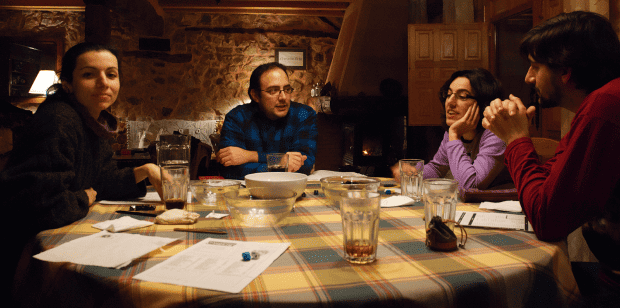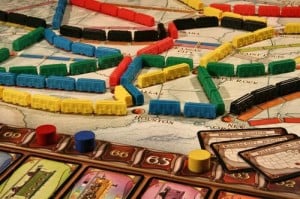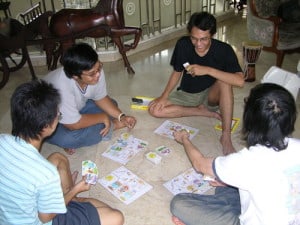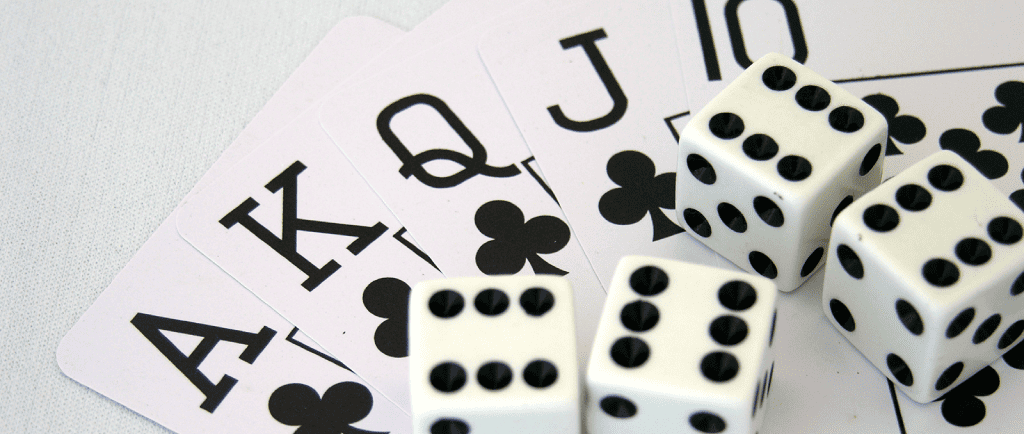
Today I continue looking at the basic elements that make up tabletop games with Interaction. The previous articles can be found here: Goals, Scoring, Actions, Resources, Uncertainty, Space and Time, Acquisition, and Elimination.
In my discussion on Actions, I mentioned that all games need actions so players can actually do something. But that’s just half of the story. Without responses to those actions, the actions are meaningless.
A GAME NEEDS TO PROVIDE INTERACTION FOR A PLAYER TO TRULY HAVE AGENCY.
A game can provide three types of interaction. First, the game can react to player actions. This is bread and butter for many digital games, which have powerful computers that can respond to players in sophisticated ways. Tabletop games also react to player actions, but the reactions must be simple enough that players can carry them out without it feeling like a chore. For solitaire and co-op games, this sort of interaction is essential.
Second, games can interact with themselves. Different pieces work together in interesting ways, and rules can yield unexpected results. This might not sound very interactive as far as the player is concerned, but discovering these interactions can be a great source of pleasure. Games with even moderately complex internal interactions can serve as fun puzzles for players to solve.
The third type, player-player interaction, is where tabletop games shine. Most tabletop games provide a framework in which players interact with each other. Even though many players get excited about fancy bits, beautiful artwork, and novel mechanics, it’s the interaction that brings friends around a table to share an experience together.

Today I’ll focus on player interaction, as it’s what sets tabletop games apart from many other games. I’ll begin by discussing some high level concepts, then look at a few specific types of interaction.
CRUEL INTERACTIONS
The first important thing to think about when it comes to player-player interaction is whether the interaction is cruel or not. Are you encouraging your players to attack or hurt each other? Lie and betray each other? Are people going to walk away from your game holding grudges?
Cruel interactions aren’t worse than other types of interaction, but they are powerful, and they aren’t appropriate for all types of games. In particular, it’s important to realize that by including cruel interactions in your game, you’ll discourage many people from playing. Depending on the game’s target audience, that might not be an issue, but understand that you will be limiting your potential player base.
Also, beware including only a few cruel interactions sprinkled in a game. The cruel interactions could easily outshine the game’s main interactions, dominating the player experience despite your intentions. If your game features cruel interactions, it’s often best to make them the focus of the whole experience.
THE RIGHT AMOUNT OF INTERACTION
In general, interaction is a good thing in tabletop games. Interacting with friends is one of the main reasons people play games! But each game has a certain amount of interaction that is appropriate. If you include too much interaction, the game can easily feel chaotic, with players feeling like they have no control or that they have no personal agency. Additionally, highly interactive mechanics, like negotiation, often take a long time. If you find your game is dragging on, ask yourself if there’s too much interaction, or if the interaction is too unstructured.
If you do find your game has too much interaction, consider focusing the interaction. In many popular games, especially Euros, players only interact in very specific ways, often times blocking each other. If players are interacting with each other in multiple ways in your game, consider dropping some of them, especially if some of those forms of interaction only come up occasionally.
Can a game have too little interaction? I think so, but I’m often surprised with how successful games are that have very little interaction. Games like Splendor and Dominion, which have extremely strong followings, have very limited interaction. How can they get away with this?

Blocking, such as in Ticket to Ride, can provide interaction without dominating a game experience. Image from Board Game Geek.
First, they often feature more subtle interaction between players than is first apparent. These interactions are often fundamental to the game’s structure. For example, in Splendor, players need to carefully monitor opponents’ tableaux to anticipate what they’ll want and block them as necessary. In both Splendor and Dominion, the players determine the end game, so not paying attention to your opponents is a good way to get left behind.
Second, if games have a lot of player-game or game-game interactions, player-player interactions might actually detract from the experience. Much of the fun of Dominion comes from exploring the many possible card combos, and interacting with other players (with, say, attack cards) tends to detract from that main fun.
Ultimately, each game benefits from having a level of interaction appropriate for its mechanics, theme, target audience, and intended use. There are no hard and fast rules, so use your judgement and feedback from playtesters to determine when your game has the right amount of interaction.
TYPES OF INTERACTION
I’d like to finish this article by discussing some of the types of interaction you might encounter in games, or consider for your own. I don’t intend for this list to be exhaustive. In fact, I believe there are some types of interaction that have yet to be included in games… maybe you’ll make a game that features something brand new! Either way, feel free to add to this list in the comments below.
Blocking. One of the most widespread and subtle types of interaction is blocking. At its most general, blocking is when one player’s actions partially determine the actions available to other players. This is the central form of interaction in most worker placement and drafting games, but is also featured in any game where players determine when the game ends. Dominion and Splendor both use blocking as their main form of interaction, and even the building component of Catan is dominated by blocking.
Often times, blocking doesn’t feel like a highly interactive mechanic. In many games players just go about their own business, occasionally becoming inconvenienced by their opponents. But skilled players will be forced to pay attention to what their opponents are doing, anticipate what they’re planning, then decide whether it’s more advantageous to pursue their own plans or try to stifle their opponent’s plans. In blocking games, players can choose how much interaction they really engage in.

Games with trading (a form of negotiation), such as Bohnanza, feature lots of interaction. Image from Board Game Geek.
Negotiation. One of the most interactive forms of interaction is negotiation, when players must collaboratively decide which actions to take. Negotiation is extremely interactive because it requires players to actually talk to each other. Games that feature negotiation prominently include Catan as well as many cooperative games including Pandemic.
Negotiation is a great way to get players to interact with each other, but it is very time consuming, so it often works best as the central form of interaction rather than in a supporting role. Additionally, negotiation can leave players feeling like they have too little agency, as the other players can simply refuse to work with them.
Reactions. In my article on Actions, I brought up reactions, or the ability for players to respond to other players’ decisions before those decisions have effects. Games that feature reactions prominently include Magic (through instants, most famously counter spells) and take-that games such as Munchkin. Reactions are highly interactive because they give players the ability to take actions intertwined with other players and force them to pay attention to other players’ actions to ensure they don’t miss an opportunity.
In my previous article, I was dismissive of reactions as complicated and clunky. I know this is a controversial stance, but I stick by it. While I know there are games where reactions are appropriate, I feel they’re overused and their downsides are not respected by most designers. Many designers justify the use of reactions by saying they’re interactive. I hope this article shows there are many alternatives to reactions to make a game interactive.
Presenting Puzzles. For example, players can present puzzles for each other! This is a fairly common but underappreciated form of interaction, where one player’s actions set up the context for the next player’s decisions (so blocking is actually a form of presenting puzzles). Magic uses this form of interaction when players decide which creatures to attack with, forcing the other player to decide how to block. Hearthstone, a game very similar to Magic, abandons reactions all together in favor of focusing on players presenting puzzles to each other. Many designers feature puzzle presentation in their games without realizing it, but being aware of the form of interaction might help you incorporate it in a more intentional manner.
Communication. Many games feature communication of information (or withholding information) as a central form of interaction. Many party games, from Pictionary to Codenames, are all about communicating with limitations. Hannabi, a popular cooperative game, eliminates negotiation in favor of focusing on communication. And many competitive games, such as Netrunner, feature hidden information and bluffing as the core interaction.

Cards Against Humanity gets people talking beyond the game, contributing to its success. Image from The Wall Street Journal.
Social Interaction. Don’t underestimate the interactions that can happen between players outside of the game! Much of the appeal of many party games is how they act as social lubricants, forcing people to talk and bringing up subjects of conversation. The wild success of Cards Against Humanity in particular is largely due to its impressive ability to get people laughing and talking (even if it’s just about how repulsive CAH is).
It may seem like this is primarily the domain of party games, but strategy games can benefit from social interaction as well. My first game, Corporate America, strives to engage people in political discussions, and helps do so with lots of humor and mechanics that encourage people to start talking. Theme, especially unusual themes or popular IPs; strange mechanics; and strategy and combos can all inspire discussions outside of the actual game that can strengthen bonds and leave your players with warm feelings related to their play experience.
IMPORTANT INTERACTIONS
Player-player interactions may not be necessary for games, but they’re one of the greatest advantages that tabletop games have over digital games. For many players, games are the preferred way to share a social experience with friends. Though each game has an ideal amount of interaction, I generally recommend you err on the side of more interaction. If your game helps your players get to know each other or become friends, it will become a happy memory even when its not being played.







